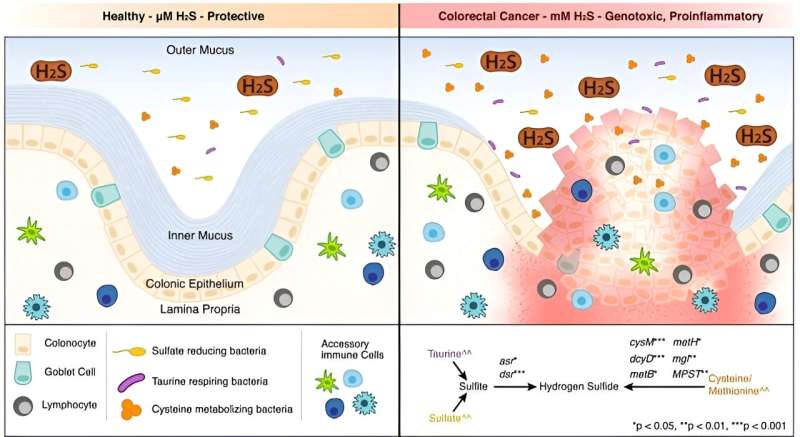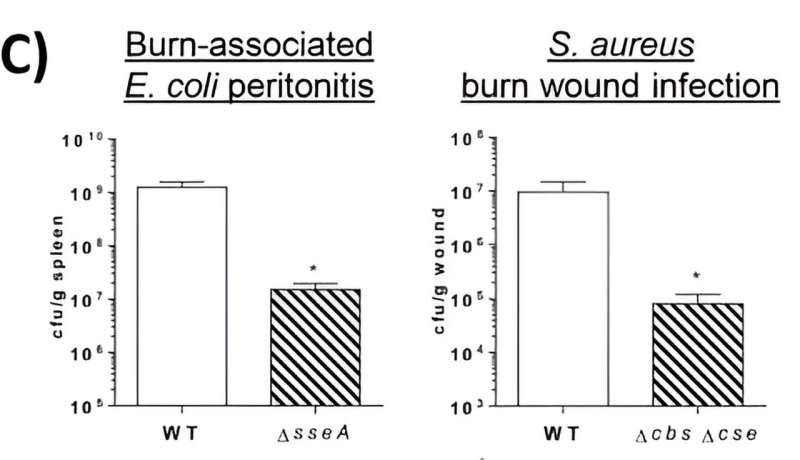This article has been reviewed according to Science X's editorial process and policies. Editors have highlighted the following attributes while ensuring the content's credibility:
fact-checked
trusted source
proofread
What stinks? The role of hydrogen sulfide in the gut

Whoever smelt it dealt it … especially if what's been dealt smells like rotten eggs. The culprit behind that eggy stink is hydrogen sulfide (H2S), a colorless, pungent gas produced by both mammalian and bacterial cells in the gut.
Besides possessing the ability to clear a room, H2S is also implicated in myriad processes that promote health—and disease. So, what's the lowdown on this gas from below?
Stinking it up: H2S production in the gut
Most people have likely experienced the stink of H2S at some point in their lives. The gas—an electron-rich molecule consisting of a sulfur atom flanked by 2 hydrogens—is used in/generated by various industrial processes (e.g., production of food, textiles, oil and natural gas, among others). It can also be found wafting from sewers, hot springs and decaying organic matter. Plants produce H2S, as do bacteria—including those that call our guts home.
Some gut microbes (e.g., Salmonella, Escherichia, Fusobacterium and more) generate H2S by breaking down sulfur-containing amino acids, like cysteine or taurine, for energy. Such sulfurous substrates may be sourced from the host diet, or the host itself (for example, taurine is often derived from microbial metabolism of bile acids).
Certain anerobic bacteria, namely members of the Desulfovibrio genus, also produce H2S via the reduction of sulfate (SO42-), a compound naturally found in various foods and drinking water. While host cells do produce H2S from cysteine and other co-substrates (known as endogenous H2S), a large fraction of the stuff floating around the gut is produced by bacteria (exogenous H2S).
Most people are familiar with gut-generated H2S as a component of flatus (as much as they wish they weren't). But how H2S is produced (and released) is one thing; how it interacts with both bacterial and host cells in the gut to impact numerous physiological processes is another.
How does H2S affect bacteria?
The conversion of sulfur to H2S provides an energy source for bacteria. Yet, the gas itself is more than just a byproduct of metabolism; it also protects microbes from environmental assaults, like oxidative stress. How? The gas scavenges for free radicals and other molecules that can damage DNA and augments the activity of endogenous, antioxidant enzymes. Further establishing its protective role, H2S has been shown to confer protection against the deadly effects of antibiotics, some of which impose oxidative stress on bacterial cells.
H2S may also be beneficial for microbial survival in the context of host-imposed stressors. For example, a 2018 study showed that strains of avirulent Escherichia coli and methicillin-resistant Staphylococcal aureus that were unable to generate H2S were more susceptible to killing by leukocytes in vitro. A lack of H2S production also facilitated bacterial clearance in mouse models of sepsis and severe burns.
Though not specific to the gut microbiota, these findings collectively suggest that H2S acts as a bacterial defense mechanism against host immune responses—including leukocytic production of reactive oxygen species (ROS)—which could be protective in the context of intestinal survival and growth.

When being gassy is good
When it comes to host health, scientists have known for several decades that H2S does a lot of good in the human body. It largely functions as a signaling molecule and is involved in everything from gene transcription and ROS reactions to cellular respiration and proliferation. The gas also serves as an important energy source for colonic epithelial cells.
Furthermore, H2S produced in the gut doesn't stay there; it diffuses out of the intestine into circulation, where it contributes to the function of organs throughout the body, including the heart, lungs and brain. Indeed, data from animal studies suggest that circulating H2S largely originates from the metabolic activity of the gut microbiota.
To that end, microbe-generated H2S may, in turn, shape the composition of the gut microbial community itself. This has a plethora of impacts on host health, including helping to train and regulate the immune system so it can recognize microbial friends from foes. Thus, H2S is both a bacterial defense against host responses, as well as a tool that shapes those responses to maintain intestinal homeostasis.
The gas also directly interacts with immune cells to influence their activation and activity. Moreover, microbial H2S production can inhibit enzymes needed for aerobic respiration by some bacterial pathogens (e.g., Klebsiella pnuemonieae), thus potentially helping to resist infection.
When H2S in the gut is rotten (eggs)
But there's a catch: H2S is toxic. Or, more accurately, it can be toxic, depending on the concentration. This "bell-shaped response" is a defining feature of H2S; it's fine in small quantities. However, if the amount of H2S overwhelms the ability of cells to use and detoxify it, then it becomes a problem.
What exactly are these problems? For one, too much H2S inhibits host cellular respiration by inhibiting a component of the electron transport chain in mitochondria and damages DNA. Large amounts of exogenous H2S have also been shown to denature the protective mucus layer that coats the intestine. When this happens, bacteria may be granted access to the underlying epithelium and trigger inflammation.
In fact, there are links between H2S-producing bacteria and inflammatory intestinal conditions, such as inflammatory bowel disease (IBD), irritable bowel syndrome and colorectal cancer. Given these links are largely associative, more research is needed to better understand the explicit roles of H2S in disease manifestation and progression. This is within the broader need for greater mechanistic insights into the gas' effects on the intestinal microbiota, and subsequent impact on host processes (e.g., the immune system).
Harnessing H2S to promote health
Outstanding research questions aside, the associations between H2S and health have motivated scientists to examine whether modulating its concentration may be therapeutically useful. For instance, exogenous administration of H2S reduced inflammation, promoted mucus production and restored the microbiota biofilm in a mouse model of IBD, highlighting its therapeutic potential.
Another recent study showed that H2S from gut microbes reacts with compounds (azo xenobiotics) commonly found in food dyes and drugs; altering dietary concentrations of a xenobiotic (Red 40) decreased sulfide levels in the mouse gut, demonstrating how diet and drugs could be tweaked to adjust intestinal H2S concentrations.
There has also been exploration into using the abundance and metabolic activity of of H2S-producing bacteria as indicators to aid in the diagnosis and monitoring of intestinal diseases.
The more researchers learn about H2S, the better able they will be to determine how it can be used for good. It's a smelly endeavor, but somebody's got to do it.
Provided by American Society for Microbiology





















